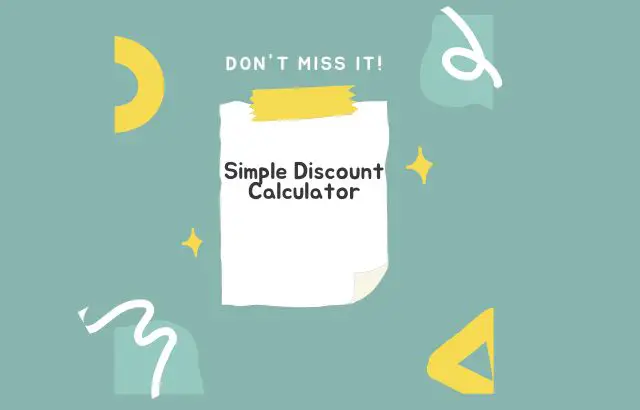Information presented on this web page is intended for informational and educational purposes only and is not meant to be taken as legal, financial, investment or tax advice. We do not accept any responsibility for any trading or investment related losses. Please review our disclaimer on before taking action based upon anything you read or see.
Nearly all of us have a natural passion for shopping, which is animated by the term “discount.” When we notice a “discount” board, we will at least quickly check to see whether the item we have always wanted to purchase is on sale. Discounts are enticing and difficult to comprehend. Thus, we have made this post on a simple discount calculator to aid you.
As per a poll by NCR Corporation, users spend more time online evaluating prices and are more inclined to “shop hop” for better bargains. Consumers are increasingly adopting the Internet as a component of their buying methods, according to the 500-person poll. 53 percent of people are doing more internet shopping and price comparisons.
46 percent want to get online or email to compare prices, coupons, and details on deals and promotions.
Consumers are constantly looking for the greatest offers; 49% of them move between merchants to get the best bargain. And eighty percent purchase items that are on sale or at a discount.
However, this relentless hunt for reductions might sometimes be difficult to determine manually. As a result, you will benefit from the Simple Discount Calculator more often. Follow along as we go into more detail about this below.
What is a Discount?
Discount refers to a break or reduction from the price of the products offered by the purchaser or the lender to the debtor at a set rate. It is distributed to entice clients and boost sales. Regarding the conditions of the sales agreement, the amount of the discount must be obtained or paid. It should be noted that the reduction is always based on the item’s listed price.
When the discount is applied, the recipient of the money receives less than what is owed. In contrast, the payer of the amount is required to pay less than what was truly owed. In other words, a discount results in a loss for the recipient but a gain for the one making the payment.
The discounted price at which investors purchase bonds is another example of a discount. For instance, an investor may only be ready to pay $950 to achieve a higher effective interest rate if a corporation offered bonds with a face value of $1,000 and an interest rate of 8%.
The issuer must pay the investor the bond’s face value when it finally matures, which results in a higher efficient cost. The result is the exact reverse when trust is sold at a bargain. In this instance, the investor receives a lower effective interest rate. Any kind of debt may be viewed using the same principle.
How to use this Simple Discount Calculator
You can use this simple discount calculator through the following steps:
- Enter the price ($)
- Enter the discount (%)
- The simple discount calculator will process your input and produce the right output.
Simple Discount Calculator
How to Calculate a Discount?
One of the essential math abilities needed to maintain a stable financial lifestyle is the ability to calculate discounts. You may use it at dining establishments, retail businesses, etc. Online e-commerce marketplaces usually advertise their websites and products by offering a certain discount percentage.
Discounts are typically calculated by multiplying the original advertised price by the decimal representation of the percentage discount. We must determine the difference between an item’s initial price and the discount to get its net selling price. You can Calculate a Discount through the following steps:
- Determine the differences between an item’s list price and its final selling price.
- Subtract the sales price from the list price to get the value of the discount portion.
- Use the formula to determine an item’s discounted price. The discount formula is S = selling price, r = discount percentage rate, and p = initial price.
S = p – RP
Types of Discounts
Businesses all across the globe employ a tried-and-true method of boosting product sales by providing discounts. Discount causes the product’s selling price to drop, which increases its allure to the consumer.
The price drop psychologically affects the buyer, influencing them to purchase. Trade discounts and cash discounts are the two sorts of discounts available.
Trade Discount
The term “trade discount” refers to a discount that a seller offers to a product bought as a price decreases.
Trade discounts are provided to boost product sales and give buyers the impression that they are obtaining the greatest deal. To track the discounts that are provided, no accounts are kept.
Cash Discount
The discount a product’s seller provides to a customer when they pay for their purchase is a cash discount. This discount is offered at the invoice value.
A cash discount is given to spur the purchaser to pay for the product quickly. It aids the company in lowering or fully avoiding credit risk.
These discounts are often used in commercial transactions where the creditor would lower the amount due from the debtor if the payment is made on time. The buyer and the seller keep accurate records for every one of these discounted transactions.
Basic Formula for Calculating Discount
A discount is an amount or percentage subtracted from a product’s usual selling price. The term “discount” refers to a decrease in the cost of a commodity or service. For instance, if the item is broken, we can ask the manager for a discount.
Discount also describes the circumstance when a bond’s price will be less than its face value. Discounts are several price reductions or deductions from a product’s cost. It is widely utilized in consumer interactions when individuals are offered discounts on various things.
When a commodity’s price is less than its quoted price, the pricing structure is referred to as a “discount.” In other words, a discount is a product price reduction that often occurs in consumer transactions when customers are given discounts on a range of goods to increase sales.
The formula for a discount may be obtained by multiplying the stated price of the product by the offered discount rate or by subtracting the cost of goods sold from its listed price. The following is a representation of the Basic Formula for Calculating Discounts in Mathematics:
S = p – RP
The discount formula is S = selling price, r = discount percentage rate, and p = initial price.
Frequently Asked Questions
How do you calculate a simple discount?
Calculating a discount is a simple process. The steps are as follows:
- Determine the differences between an item’s list price and its final selling price.
- Subtract the cost of goods sold from the list price to get the value of the discount portion.
- Use the following formula to determine an item’s discounted price: S = p – RP.
How do I calculate a discount percentage?
You can calculate a discount percentage through the following steps:
- Deduct the final cost from the start-up cost.
- Multiply this result by the original cost.
- Multiply the outcome by 100.
- You received a percentage-based discount.
How do you take 20% off the price?
By reducing the original price by 5, you may get 20% off a purchase. Alternately, double the initial cost by 20 and divide it by 100.
How do you calculate 15% off?
The steps listed below may be used to generate a 15% discount:

Expert Opinion
For some reason, businesses provide discounts to consumers. A company can attempt to draw in a different clientele or raise demand for a certain commodity or service. Firms need to ensure they can either draw even or turn a profit at a reduced price, regardless of the motivation for the reduction. Some businesses may find a little initial income loss worthwhile, given the expanded consumer base. In all, the Simple Discount Calculator will aid you immensely.






